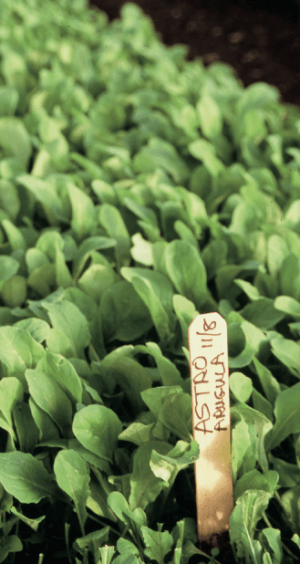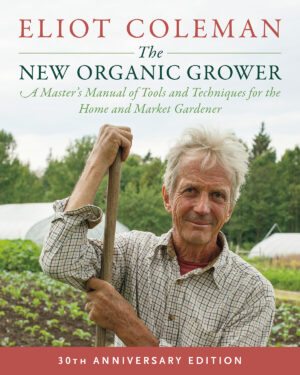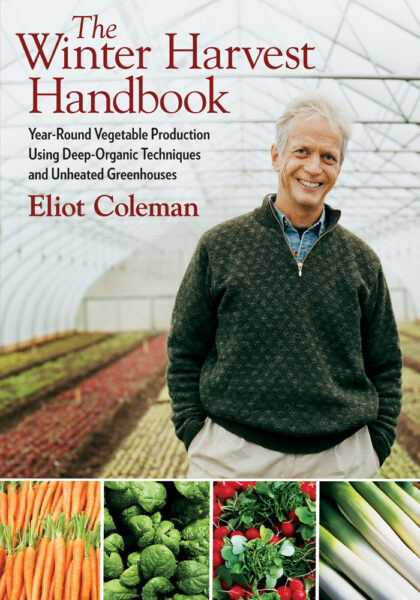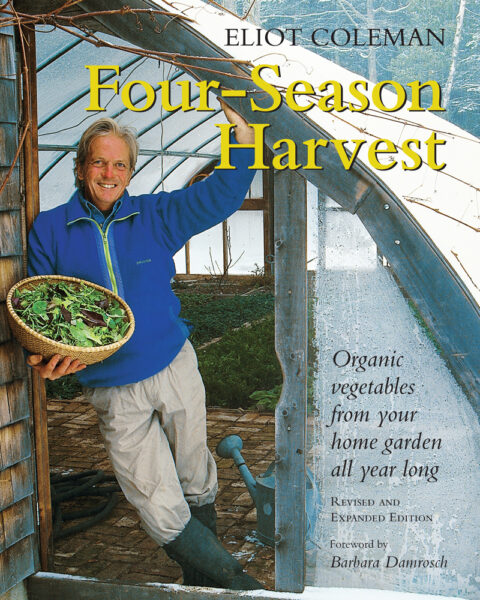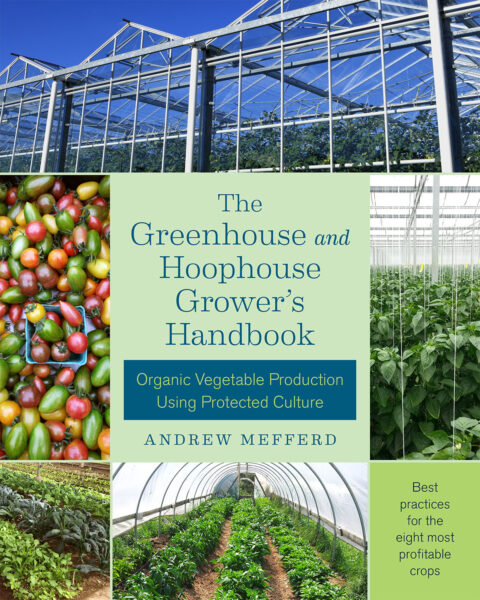The Winter Harvest Project
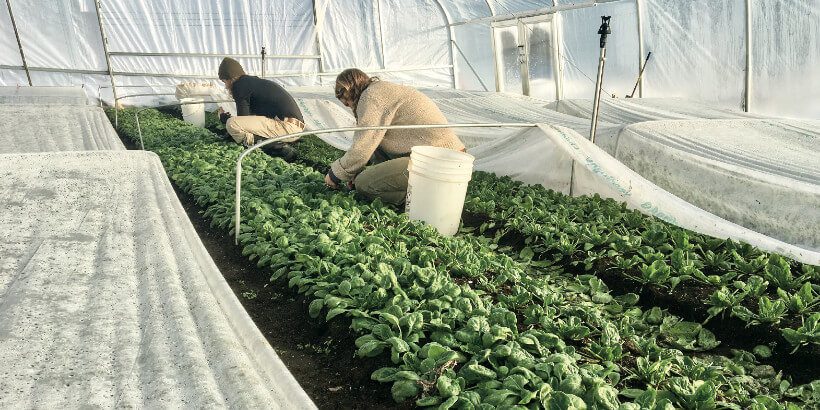
Four-season farmer Eliot Coleman strikes again with inspiration for all you cold-loving farmers out there! A master of extending the growing season, Eliot explains his strategies for a successful winter harvest and greenhouse design.
The following excerpt is from The New Organic Grower, 3rd Edition by Eliot Coleman. It has been adapted for the web.
The Winter Harvest
Part of my fascination with greenhouses and greenhouse systems arises from a desire to supply food to my customers for as much of the year as possible. I think I benefit their health by growing vegetables of an exceptional quality.
I know I help support a vibrant local economy by keeping the money circulating within my community. As a local grower I have an important advantage over the large wholesale shipper: I provide fresh vegetables. So I don’t care if the trucked-in crops can claim they were grown with pure stardust by elves and fairies.
Any vegetables picked in bulk and shipped through the wholesale system are not fresh. Mine were picked today and are on the customer’s table tonight or tomorrow. I can compete on that fact alone.
How the Winter Harvest Succeeds
If I’m going to stress that freshness angle as part and parcel of my farm, I want to make it happen for as much of the year as possible so as not to disappoint my customers—whether stores, restaurants, co-ops, or neighbors—or lose them to another supplier. But I want to do this without excessive expenditure of energy.
The winter harvest succeeds by combining the technology of climate modification with the biology of the vegetable world.
The technology consists of two layers of protection to temper the harsh blasts of winter; the plants grow under a layer of spun bonded fabric inside an unheated greenhouse. The biology involves the selection of cold-hardy vegetable varieties.
These traditional winter crops don’t mind the short days, nor are they harmed by freezing or by remaining frozen for periods of time.
Extending the Harvest Season
Our goal has always been to extend the fresh vegetable harvest season throughout the winter months by using low-input solutions powered by on-farm resources.
The criteria for achieving that goal focus on environmentally sound practices that minimize use of energy and resources.
The list of criteria is posted on the wall of the greenhouse to keep us paying attention to how we might do it even better:
Arugula
Climate-adapted. Exploiting the potential of simple, protected microclimates for the production of hardy crops during the cold months.
Sunlight-driven. Minimal technology pipe-frame greenhouses covered with a single layer of exterior plastic and adding single-layer interior covers. No supplemental heat, no perimeter insulation.
Nature-directed. Working with rather than against the realities of cold conditions. Successfully growing cold-hardy crops in the cold months through understanding the influence of day length and soil temperature on time from planting to harvest. Benefiting from the adaptation of numerous cultivars to winter light and winter temperatures.
Farm-generated. Using homemade compost, cover crops, and sod-based crop rotations as the principal inputs to nurture a fertile soil.
Pest prevention. Emphasizing balanced soils as part of a plant-positive management system. Including mobile greenhouses to avoid pest buildup in covered environments.
Weed prevention. Focusing on shallow tillage, timely cultivation, solarization, and flame weeding to prevent weeds from growing or going to seed.
Practical tools. Searching out the simplest, most effective tools (and often making or modifying them ourselves) for each task from soil preparation through harvest.
Nutritionally sound. Providing all the nutritional benefits of truly fresh food by focusing on local production for local markets.
Resource efficiency. Saving energy since winter crops locally grown in unheated structures require only 5 percent of the energy used for long-distance transport.
Eco-rationality. Stressing both economic and ecological principles. Earning a good living for farmers and having a positive influence on the health of our customers and the local environment.
In order to achieve a decent income during the coldest months of winter we expend some energy by adding minimal heat to one greenhouse. We keep it just above freezing by burning wood and propane.
That gives us a greater variety of crops, beyond those that are successful in the unheated houses, to attract customers to our winter farmers markets. The increased business offsets the cost of heating by about four to one.
Dealing With Weeds
My weed solution in the winter greenhouse is to dispatch them young and never let any go to seed. I can’t emphasize this point enough: Get on top of weeds at the start, and stick to it.
The way to achieve that goal is very straightforward. Most weed seeds germinate in the top 2 inches (5 centimeters) of the soil. Get rid of those seeds, and the problem is solved.
As long as I till shallowly and don’t continually bring up new seeds from lower layers, the weed seed reservoir in the top 2 inches of soil is exhausted after three to five years, and the foundation for clean cultivation has been laid.
So for weed-control purposes I think of the winter greenhouse as the “Five Centimeter Farm” and use two-weed prevention/weed-suppression techniques.
First, I do all the surface soil preparation with the electrically powered Tilther, which is designed to only till shallowly and let deep weed seeds remain buried.
Second, we solarize the greenhouse soil for a month in summer every three years, as necessary, to kill any weed seeds in the top 5 centimeters by reaching a soil temperature of 145°F (63°C) at the 2-inch depth.
Handling Pests
I have experienced very few insect and disease problems in the winter garden.
Initially I felt the greenhouse might be introducing an artificial factor that could make plants more susceptible. I am convinced now that any effect is minimal as long as well-finished compost and crop rotations are used.
The only disease I have seen was a little gray mold fungus (Botrytis spp.), which didn’t surprise me, since it thrives in cool, damp conditions. I now prevent it by venting off moist air in the mornings.
Prevention is a time-honored greenhouse practice. In Dutch organic greenhouses I have seen specially designed vacuum cleaners used before planting a new crop to remove any leaves or other partially decayed organic residues from the soil surface so they cannot serve as substrates for disease organisms.
I don’t use a vacuum, but I do spend time cleaning up crop residues and keeping stems trimmed close. I try to manage the greenhouse environment so as to encourage only the plants.
Crop Quality During the Winter Harvest
The quality of winter garden crops is continually high, both visually and in terms of flavor, tenderness, and just plain eating pleasure. We do everything we can to ensure optimal soil conditions, and it obviously pays off.
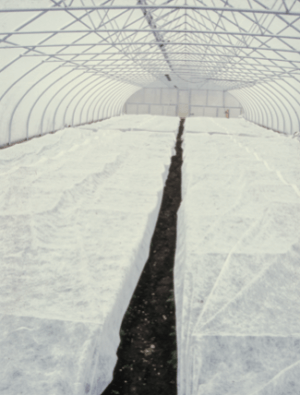
An inner layer of floating row cover.
The major quality problem sometimes seen in winter hothouse crops—high nitrate content—is not a problem in this system.
That’s because none of the causative factors are present: use of soluble nitrogen fertilizers, forcing crops in low-light conditions at high temperatures, lack of trace elements, and the use of susceptible varieties.
We fertilize only with well-humified, one-and-a-half- to two-year-old compost; we don’t force the crops; we have plenty of trace elements in the soil, and we are not growing special winter-forcing varieties.
The Mobile Greenhouse
Plus there are positive factors operating, thanks to the mobile greenhouse.
There is no continuous buildup of nitrates or other salts in the soil as there would be in a permanent greenhouse, because this soil is uncovered for one year out of every two.
In addition, the crops that we are harvesting during the lowest winter light (mid-November to mid- February) were all sown outdoors in the fall.
They stopped their growth naturally as a result of declining temperatures and day length. The greenhouse covering then arrived to protect them (the same as if we had moved them to a milder climate). We have extended the harvest season for crops sown during the growing season.
Low Winter Sun and Greenhouse Layout
The other reality of short winter days is low sun angle. Be sure your greenhouse site won’t be shaded by trees, hedges, houses, a mountain, or other greenhouses.
The amount of change in angle from summer sun to winter sun always surprises me. At our latitude (44 degrees north) the noon sun has an altitude angle of 69 degrees on June 21, but only 22 degrees on December 21.
I have to constantly remind myself to pay attention to where the winter shadows will fall when I am laying out greenhouses.
Planning Your Greenhouse for the Winter Harvest
I plan my greenhouses with the long axis running east-west to maximize winter sun. To the south of 40 degrees north latitude, a north-south orientation is recommended.
You need to be aware that true south for greenhouse layout is not the same as magnetic south at most locations. You will need to determine your magnetic declination from a topographic map and adjust accordingly.
Managing Shade & Sun
When the sun is low in the winter sky, a 10-foot- (3 meter) tall greenhouse running east-west will cast a shadow 25 feet (7.6 meters) long; a 12-foot- (3.7 meter) tall greenhouse will cast a 30-foot (9 meter) shadow.
Thus, a second greenhouse behind the first should be sited at least that far away so as not to be shaded.
In the past I have often used that winter-shade area to grow outdoor summer crops (they benefit from the windbreak created by the greenhouses), or I have covered that ground with temporary greenhouses in spring and summer when the sun is higher in the sky.
Snow: A Reality of the Winter Harvest
There is one final reality of winter in addition to cold temperatures and low sun: snow. With heated greenhouses the standard practice is to turn up the heat during a snowstorm so as to melt off the snow.
For unheated and low-temperature production, I take a different approach. My greenhouses have a Gothic-arch roofline and heavier pipe construction; both features make for a stronger structure with a shape that sheds snow better.
Although the snow slides off the roof, it doesn’t go away. A heavy snowfall remains piled up against the sides and can block sun.
If you shovel by hand, pay attention. You can easily jab the snow shovel through the greenhouse plastic (I have done it more than once).
If you have a lot of greenhouses, a snow blower is the tool of choice. The snow blower can remove snow from right alongside the wall of the greenhouse without creating back pressure as a snowplow would.
Recommended Reads
Recent Articles
Asparagus is a delicious vegetable with a layered history. How did this aspiring spear make its way from growing in the wild to appearing on our plates? The following is an excerpt from the The Seed Detective by Adam Alexander. It has been adapted for the web. “Nature gives us the key to every secret…
Read MoreInterested in growing trees? Here are some tips on successfully planting, transplanting, and pruning trees to create a flourishing forest garden! The following is an excerpt from The Home-Scale Forest Garden by Dani Baker. It has been adapted for the web. Planting Potted Trees and Shrubs If you order potted trees, check with your supplier to…
Read MoreWith the right strategies and practices, composting on a small farm is surprisingly easy and inexpensive. Just follow these steps for making compost, and your farm will be thriving in no time! The following excerpt is from The Lean Farm Guide to Growing Vegetables by Ben Hartman. It has been adapted for the web. (All photographs by Ben…
Read MoreGarlic mustard: while known as “invasive,” this plant can be consumed in its entirety and has great nutritional value. Plus, the garlic-flavor is a perfect addition to any recipe that calls for mustard! The following are excerpts from Beyond the War on Invasive Species by Tao Orion and The Wild Wisdom of Weeds by Katrina…
Read MoreEveryone loves a refreshing, fermented, nutritious drink…even your garden! Take your fermentation skills out of the kitchen and into the garden by brewing fermented plant juice. The following is an excerpt from The Regenerative Grower’s Guide to Garden Amendments by Nigel Palmer. It has been adapted for the web. How to Make Fermented Plant Juice Fermented…
Read More

